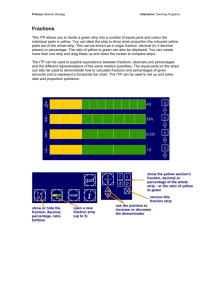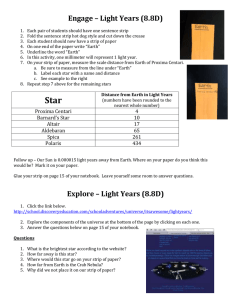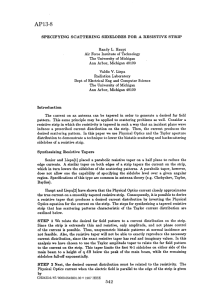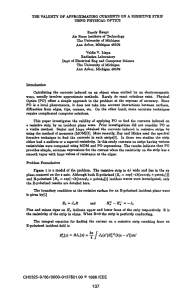NULLS CO 69-1 IN
advertisement
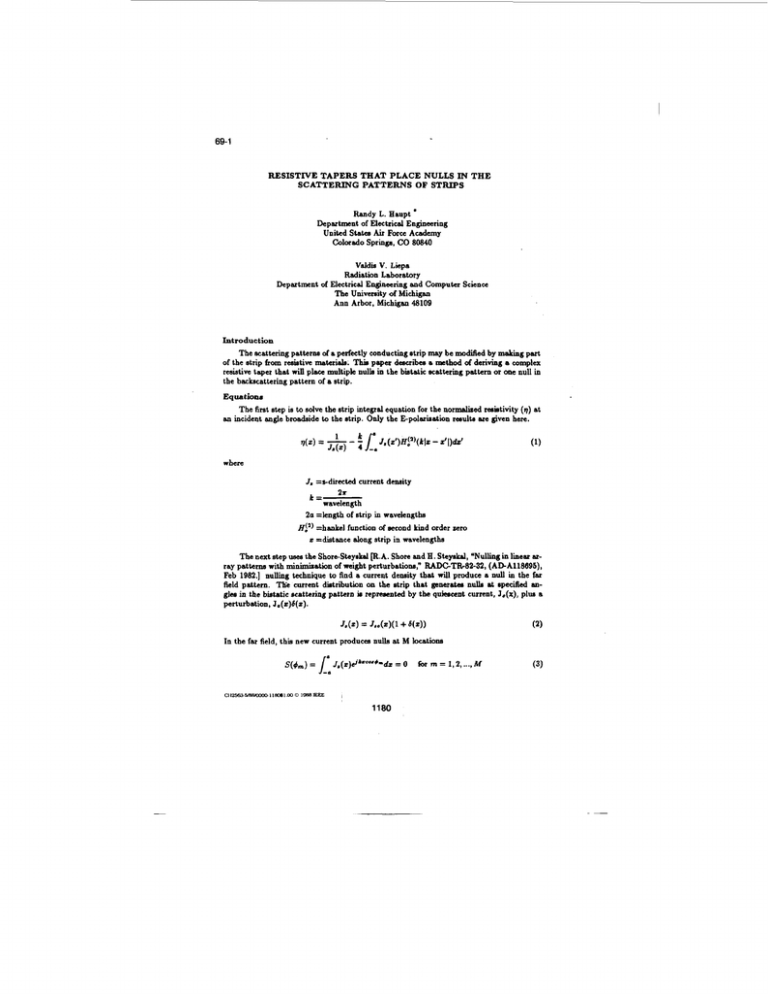
69-1 RESISTIVE TAPERS THAT PLACE NULLS IN THE SCATTERING PATTERNS OF STRIPS Randy L. Haupt Department of Electrical Engineering Unikd States Air Force Academy Colorado Springas,CO 80840 Valdia V. Liepa Radiation Laboratory Department of Electrical Engineering and Compukr Science The Univemity of Michigan Ann Arbor, Michiian 48109 Introduction The mattering patterns of a perfectly conducting strip may be modified by d i g part of the strip from resutive materisb. Thk paper dacribcm a method of deriving a complex resistive taper that will place multipk nulla in the bistatic scattering patkrn or one null in the backscattering pattern of a strip. Equation. The first step is to solve the strip integral equation for the normalired rabtivity (q) at an incident angle broadaide to the strip. Only the &polariaation result. are given here. where J, =s-directed current density k = 2* wavelength 20 =Length of strip in wavelengths If:') t =hankel function of second kind order zero =distance along strip in wavelengths The next step usen the ShorcSteyakd [R.A. Shore and E.Steyskal, "Nulling in l i e = CAIray patkrns with minimiration of weight perturbations," RADGTRr82-32, (ADAll8695), Feb 1982.1 n u k g technique to find a current density that rill produce a null in the far field pattern. Tke current distribution on the strip that generates n& at specified angles in the biatatic scatkring pattern M represented by the qukscent current, Jo(x), plus a perturbation, J.(t)6(+). J,(+) = J,o(z)(l+ a(+)) In the far field, this new current produces nulla at M locations where S(9) is the relative far field pattern. The above integral may then be solved using mid point integration N N Jndk**co'*m = A c ( 1 + 6n)J0neJkrsc0'*m = 0 =A S(9,) n=l (4) n=l where Jn = current that produces nulla in the far field Ja = quiescent current 6, = perturbation to the quiescent current A = = length of current segment S = far field pattern , Rearranging ( 4 ) into a form amenable to matrix solution yields N A6n J a dkS.CO#*m "4 =- c N A J adk*.COS)m = -So($,), m = 1,2,...,M (5) n=l where So is the quieacent relative far field pattern. Now that (4) is in the form of M equations with N unknowna, where M<N, a le& solution to the matrix equation is given by squares solution is paaible. Usually,the minimum norm ( A t A ) z = A'b If the current perturbations are minimized in a least mean square sense N 16,1' = minimum (7) n=l then the components of ( where 6) take the form is the transpose of the vector. The minimization in (7) is not unique. ResultI Figure 1 in an example of placing a null in the far field backscattering pattern of a perfectly conducting strip at 75'. The quiescent pattern is superimposed on the nulled pattern. Figure 2 shows a null placed in the backecattering pattern of a tapered resistivestrip at 2W. In both examplesthe resistive taper is complex and the current density perturbations are small. 1181 , ,r 9 c -20 -2.0 x 0.0 ~UAVELENGTHSI 20 0.0 x 20 NAVELDIGTHS) b. NarnUzed reshtlvr t q a for dllng P I 3.1 v Figure 1. Nulls are placed in the Epolarired backscattering pattern at 75”. The strip is 4X wide and was originally perfectly conducting. The solid line is the nulled pattern and the line with circles is the quiescent pattern. 1182 1 -- - NULL OUIESCENT RERL PART -1Iyu;ItMY PART i s ! - O J -2.0 0.0 20 X (UAVELENGTHS) a !lagnltudc of lnduced current h l t y on rtrlp. #.=90' - -NULL WESCENT b. Norrallzed reslstlvr taper for nUlllW I - - M u MmscENT n 0, -? 0 IS 90 135 180 p0 c. Blrtstlc rstterlnp psttrm. p.40' d. Backrwttalnp m t f m Figure 2. A null is placed in the Epolarized backscattering pattern at 20". The strip is 4X wide and has a low sidelobe resistive taper . The solid line is the nulled pattern and the line with circles is the quiescent pattern. 1183 I



